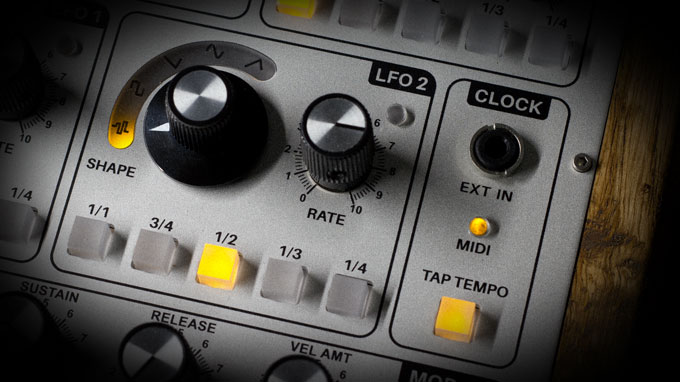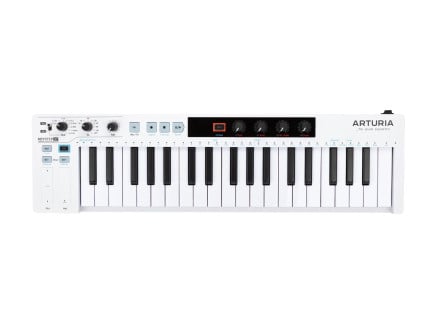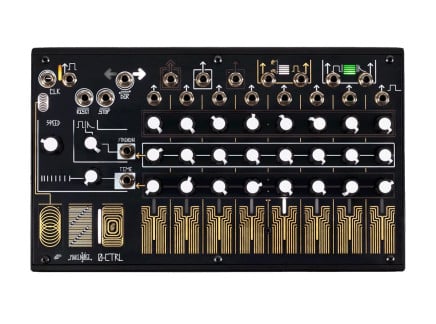Continuing a thread started in our recent articles about East Coast and West Coast synthesis, it seemed only fitting to focus in on Majella Audio's Implexus: a modern-day analog desktop synthesizer that borrows equally from both schools of sound design.
Implexus takes some of the most compelling sonic aspects of Buchla and Moog's respective styles of synthesis, pairing them in uncommon ways to present a fresh take on otherwise classic sounds. Beyond that, though, it presents several of its own unique takes on rhythm, modulation, and more. So with no further delay, let's take a look at what's going on inside Implexus.
Majella Implexus: East + West Coast Combined
On paper, Implexus is a self-contained analog desktop synthesizer with options for MIDI or CV control from external sources. In order, Implexus's audio path features two primary sound sources (the Basic Generator and Complex Generator), suboscillator, mixer, a resonant filter, and a stereo digital delay. The modulation section includes two LFOs, two envelopes, and a Eurorack-style 3.5mm patch bay on the instrument's rear. The instrument on the whole takes the interesting approach of using backlit LED rings behind several critical parameter controls that reflect their respective parameters' current settings—even accounting for modulation. As such, it's very easy to see at a moment's notice how the synth is behaving overall, and even aside from the practical usefulness, it makes for quite a nice light show. All that said, let's take a closer look at what each Implexus's sections entails.
The oscillators showcase Implexus's most significant "West Coast" influence. The Basic Generator is simple enough to describe: it's a fairly straightforward oscillator with square, sine, and saw shapes, a fine tune knob, and an octave select switch. The Complex Generator, though, is where things get a bit more interesting. Taking inspiration from classic Buchla instruments such as the Music Easel and 259, the Complex Generator is based on warping a sine wave through a wavefolder, generating highly complex timbres through use of the Harmonics, Folder, and Bias parameters. Also similar to the aforementioned Buchla designs, it's possible to use the Basic Generator as a modulation source for the Complex Generator, providing audio-rate linear frequency modulation (FM) and audio-rate modulation of the wavefolder itself. Of course, the envelopes and LFOs can also be used to modulate both oscillator pitch and the wavefolder—leading to an enormous range of sounds from slowly evolving drones to unruly, clangorous audio-rate modulation textures.
Like the Basic Generator, the Complex Generator features an octave range switch and fine tuning knob, making it very easy to dial in specific intervals between both oscillators. Like a typical monosynth, these oscillators each track incoming MIDI data—so it's super simple to create stacked oscillator sounds...a sound considerably more common in "East Coast" synths. Despite being possible on many other instruments, these types of textures with a wavefolder is a peculiar combination well worth exploring. The dedicated glide/vibrato section brings additional traditional monosynth-style goodness to this otherwise fairly peculiar instrument. The handy built-in VCO tuner also makes it super easy to tune without even needing to hear the instrument, which...is a pretty handy feature.
The oscillators (and suboscillator) are summed with a dedicated mixer just before the 12dB/oct resonant filter, which features both lowpass and highpass modes. Though not the 24dB/oct you might expect from a classic Moog, the resonance allows for a huge range of thumping, squelchy sounds. Using the basic generator as a sound source yields plenty of classic almost Roland-esque tones, while the Complex Generator introduces peculiar harmonic characteristics that combine beautifully with higher resonance settings. In the best cases, the resonant peak can become a powerful tool for accentuating specific wavefolding harmonics or creating an additional layer of movement in deep, heavily-modulated drones. The filter features an internally normalled connection to the "mod" envelope, making classic articulations and filter ducking tricks quite easy to access. Regrettably, there is no way to modulate the filter with the tempo-synced LFOs...though the mod envelope has some interesting related tricks up its sleeve.
The digital delay features a straightforward set of controls for mix, time, and feedback amount (regen). It's a clean, clear-sounding delay that pairs beautifully with the rich, detailed sound from the oscillator section. Perhaps the most interesting feature, though, are the five buttons at the bottom of the delay section, which each correspond to different tempo divisions of Implexus's master clock. This makes it possible to sync the delay time to a MIDI clock, tap tempo, or an external Eurorack-style pulse, with the individual buttons corresponding to specific divisions of that rate (1/1, 3/4, 1/2, 1/3, and 1/4, respectively). This makes it insanely simple to access rhythmic delay effects that otherwise would require a significant amount of careful listening—and to achieve the otherwise impossible task of switching time divisions instantly as you're playing. This...is sick.
 Detail of Implexus's LFO section
Detail of Implexus's LFO section
And that brings us to the LFOs. The LFOs are fairly straightforward, each offering dedicated rate controls and shape selection switches (with stepped random, square, saw, sine, and ramp shapes). Like the Delay, though, the LFOs feature these performable clock division buttons—turning modulation rates into a highly playable parameter, and turning otherwise simple LFO routings into complex sources of pulsating polyrhythmic potential. Even a simple drone can take on new life as a driving, pounding rhythmic process. The LFOs feature internal routings to the oscillator's pitch and wavefolding parameters, permitting a wide range of timbral evolution.
Though they don't feature tempo sync options, the envelopes are similarly flexible. Each is an ADSR style envelope with variable velocity response. The Mod EG features a looping mode, in which the Attack and Decay controls are used to determine the overall modulation shape/speed. The Amp EG features a dedicated drone switch—and given all of the built-in potential for creating sonic interest from modulation, tempo syncing, and the delay alone, it's very possible to play Implexus without the need for an external MIDI controller or CV source.
In terms of playability, Implexus features MIDI In and Thru via 5-pin DIN, as well as USB MIDI. The rear-panel 3.5mm patch bay features dedicated outputs for the Complex Generator, Basic Generator, and the Clock, as well as inputs for Fold, Bias, Harmonics, and the Filter's cutoff. Additionally, 1V/Oct pitch and standard gate inputs make it easy to play Implexus from external sequencers, modular gear, or other CV-capable controllers (for instance, Make Noise's 0-CTRL could make quite a fantastic pairing). Beyond simple pitch/gate data, though, this presents a pretty huge opportunity for expanding Implexus's capabilities altogether. You could use the oscillators to apply audio-rate modulation to the filter; you could use external LFOs or other semi-modular devices to modulate all of the instrument's most crucial parameters; heck, you could even use the Complex Generator to modulate its own waveshaping parameters for some particularly chaotic gnarliness.
A Coast All Its Own
While not the first self-contained patchable synth to tackle the idea of pairing East and West Coast approaches to synthesis (don't forget about 0-Coast!), Implexus does offer its own unique, refreshing take on how these synthesis ideologies can play together. Moreover, it does it while injecting a fair number of its own unique ideas—the instantaneous and independent access to different clock divisions on each of the LFOs and the delay make for a playing experience that heavily leans toward polyrhythmic exploration of evolving synthesis textures.
Paired with the sheer richness of the Complex Generator's wavefolder and the liquid bite of the resonant filter, this rhythmic focus makes a perfect way of exploring ever-changing pulsating drones, jackhammer-esque abrasive textures, or slowly-evolving, yet clearly-organized sonic meditations. Though its marketing focuses on the East Coast/West Coast clash, Implexus does feel like its own instrument with its own style of playing, producing plenty of sounds you're not likely to find on either a Music Easel or a Minimoog.














